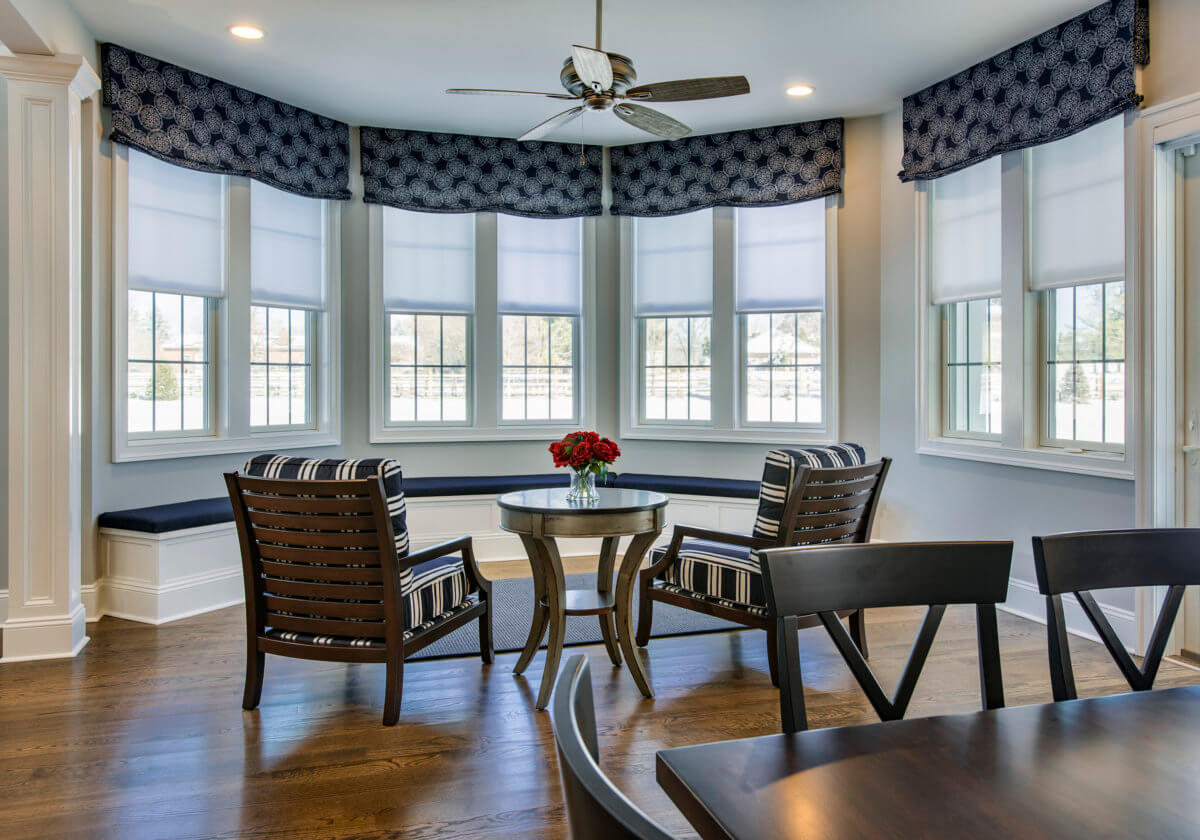
Functional Practicality and Aesthetics. These are the two primary purposes of window treatments. Hard window treatments give you the privacy you need, the light control you desire, and the convenience you deserve. Hunter Douglas window treatments are custom made to precisely fit not only your window, but your exact style preference too. While these shades truly are gorgeous, coming in all types of fabrics, colors, and textures, there is something to say about the aesthetic appeal combining window treatments can add to your space with drapery panels, valances, or cornices as the perfect finishing touch!
Soften Your Space

Soft Treatments help frame your window, eliminating hard edges and corners with a subtle look and feel. They are the high heels or designer bag to your outfit, the perfect accessories to your hard window treatments! By pulling from your surrounding furnishings and décor, soft treatments can tie the room together, adding interest and dimension with a pop of color or a bit of flare, without obstructing your view. Countless prints, patterns, textures, colors, and designs are available for you to explore, ensuring you find a variety of options that stay true to your style and accomplish the overall look you desire!
Soft Treatment Styles
Drapery panels, Valances, and Cornices are the main styles of soft treatments, each with unique styles of their own.
Drapery Panels

Drapery panels are a popular choice among our clients. Not only do they look gorgeous in their long, flowing glory, they offer other aesthetic and practical benefits as well! For instance, you can make any small window appear bigger by mounting the drapery rod well above the window frame. Increased energy efficiency, light control, and privacy are other perks of combining drapery panels with your hard treatments.
Pleated panels are classic and timeless, perfect for any space in your home. A variety of pleats can be formed, yet the two most common today are the pinch pleat (with equally spaced single, double, or triple pleats) and goblet pleat (similar to a triple pinch pleat but shaped to form a goblet silhouette).
Cornices and Valances

Cornices and valances are great options to add a splash of color and interest with less fabric than panels! While similar in nature, these types are slightly different from one another in their design. Fully upholstered and mounted to a board, cornices are stationary treatments that give off a crisp, formal look into your space. Coming in a variety of styles, the straight and arched cornices are currently trending. Valances are still mounted to a board but have a softer appearance with fabric hanging freely in a variety of styles. Both Faux Roman and box pleated valances are widely popular right now.
Hard and Soft Treatment Combinations

Combining window treatments may seem like an overwhelming task with so many styles and options available, leaving you at a loss of where to begin. Don’t Fret! That’s what we are here for! You may not think that you have an eye for design or know what’s trending, but in all reality, there really isn’t any set rules or a “right” and a “wrong.” Through our knowledge and expertise, we can help guide you in narrowing down your options.
Tips and Trends

We recommend keeping your hard, Hunter Douglas treatments solid and neutral, adding visual interest and color with soft treatments. Currently tone-on-tone styles in blues and grays are trending with simple, subtle patterns incorporated into the fabrics. Drapery panels look great paired with plantation shutters or a pleated Roman shade and are typically used in living rooms and bedrooms. Valances and cornices are a great way to cover up the basic headrail of a roller shade. They are commonly found in kitchens to create visual interest with a pop of color in an appliance-filled space. The combinations and options are endless; in the end, it comes down to what YOU like, so…
Go With Your Gut!
Ask yourself the following questions when making window treatment considerations…
How do you want to feel in this room?
Do you like a pop of color?
Is there a surrounding furnishing to draw the eye to and compliment?
How much coverage do you desire?
Are you looking to entertain in this space?
What is your overall décor style?
By answering these questions, we can consider colors that evoke moods, prints or styles to coordinate with, and the best way to stay true to you!
Schedule a Consultation!
Give us a call to schedule a Free Design Consultation in our showroom. We have all of the Hunter Douglas treatments on display for you to see firsthand and operate. Cabinets and shelves are filled with over 500 books of fabric from well-known fabric vendors including Carole Fabrics, Stout, Kravet, Pindler, Perennials, Designers Guild, and more! Whether you are combining window treatments together at once, in stages, or are only interested in one type over the other, we would love to give you a hand in making the perfect window treatment selections for your home.
267.898.0200
